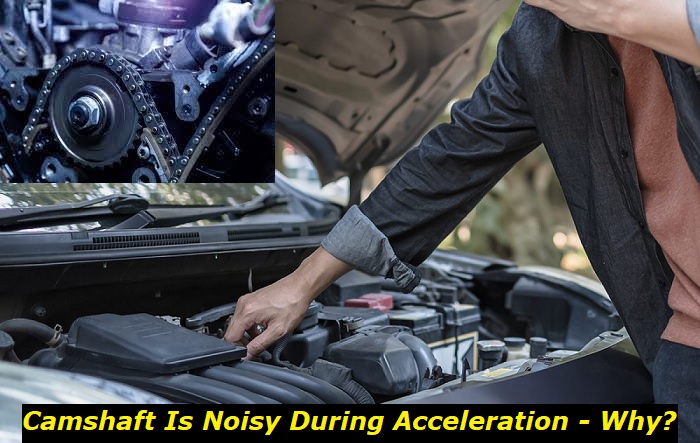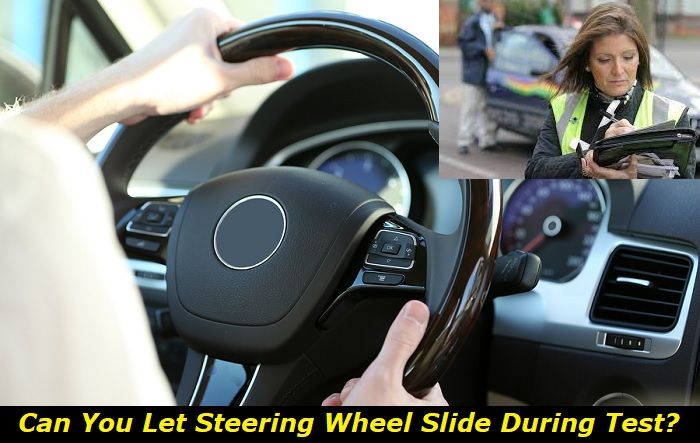Considering the complexity of the engine, hearing a strange noise from it can be a nightmare. That's because many moving components inside could be the source of the strange noise. But it doesn't have to be a nightmare. This article will cover the different types of camshaft engine noises when accelerating, how to locate the noise, and fix the issue. But first, let's briefly examine how the camshaft functions.
Camshaft problems highlights
- Level of importance:Medium
- Commonreasons:Variable valve timing actuator problems, cam bearings issues, overheating
- DIY inspection:Possible but complicated
- DIY repair:Impossible
- Price for repair:$350 - $850
- Can you drive?Usually, yes
- Ways to fix:Clean the VVT (VCT) solenoids, inspect the camshaft, clean the valves

What Type of Camshaft Noise Should You Look Out for During Acceleration?
When the camshaft is faulty, it can produce different types of noises. Some of those noises are a rattling noise, a ticking sound, a knocking, a clicking, a tapping, or a whining sound from the engine. One way to tell the noises apart is by using a mechanic's stethoscope.
Most mechanics use a stethoscope to identify the type of noise coming from the engine. This helps make an accurate diagnosis. Most engine noises become more audible during acceleration. This is because the engine is working harder to meet the demands of the vehicle when accelerating.
What Causes the Camshaft Noise When Accelerating?
There are various causes of camshaft noise that you'll likely hear when accelerating. Some common ones are:
1) Collapsed Hydraulic Lifter Tappet
A hydraulic lifter tappet is a mechanical device that opens and closes an internal combustion engine's inlet or exhaust valves. It does this by converting the sideways motion of the cam lobe(when the camshaft is rotating) to a vertical motion that opens the valve.
It's also called the hydraulic lash adjuster or the hydraulic valve lifter. The lifter also prevents excessive clearance in the valve train and allows a timely mixture of fuel and air.
When the valve is closed, a pressurized oil feed from the oil pump aligns with a groove in the tappet. This provides lubrication to the mechanical device. When the tappet doesn't receive enough lubrication, it wears out or develops a leak causing it to collapse. This can be attributed to using a low-grade oil or the formation of sludge that clogs the oilways.
The lifter could also be sticking due to a build-up of varnish. A Collapsed or sticking lifter reduces valve opening gaps, causing a decline in engine performance. You'll also hear a ticking noise coming from the top of the engine that becomes pronounced when accelerating.
2) Worn-Out Cam Lobes
A worn-out camshaft lobe is another common cause of a camshaft noise when accelerating. Even small wear or pitting on the cam lobes can affect the valve timing by a large degree. This shows the importance of cam lobes being in good condition. The cam lobes wear out because of the many years of operation. Other causes of the cam lobe damage are:
- Presence of dirt or debris on the camshaft shaft.
- Poor lubrication due to a lot of clearance space or clogged oil passages.
- Low oil pressure.
- Out-of-position hydraulic lifters or misaligned valves.
- A decline in spring valve pressure.
- Overexertion of camshaft due to overspeeding.
Wearing out of the cam lobes produces a loud tapping noise while accelerating. Other effects of damaged cam lobes are reduced economy and a loss of horsepower.
3) Damaged Timing Belt
Although the timing belt is made from high-quality rubber, it's prone to wear out or damage after a long period of use. The timing belt connects the camshaft and the crankshaft through a series of pulleys. The timing belt or hydraulic tensioner can wear out prematurely due to insufficient lubrication and low-pressure oil. This can lead to missing teeth.
If you continue to operate with a worn-out timing belt, it may break, leading to further complications. You'll likely hear a ticking or rattling sound around the engine bay when the timing belt starts to wear or becomes loose. This is due to the timing chain contacting the timing cover or chain guides.
The sound becomes more audible during acceleration. Other symptoms that signify the timing belt is worn-out are:
- Oil leakage from the timing cover.
- The car engine takes longer to turn over.
- Abnormal RPMs(Revolutions per Minute)
4) Damaged Camshaft Bearings
A worn-out camshaft bearing could also be why your engine produces the strange grinding, whining, or squeaky noise. The function of the cam bearing is to provide a base for support and allow proper rotation of the camshaft. The bearing design allows it to endure the forces that come with frequent rotation of the cams.
However, like other engine components, the camshaft bearings can yield to the test of time and fail after many miles of service.
A damaged camshaft bearing will likely produce a knocking or ticking sound. Some reasons causing damage to the camshaft bearings are
- Low oil pressure.
- Contaminated or low-quality grade oil.
- Improper installation.
- Excessive vibration
5) Misaligned Rocker Arms
A rocker arm is a center-pivoted lever that pushes the exhaust or intake valve to open. This provides power to the internal combustion engine. The rocker arm can become loose, break or misalign, affecting the valves' opening and closing and disabling the cylinder related to it. This, in turn, can affect the drivability of the car and the engine's performance.
One of the tell-tale symptoms of a misaligned rocker arm is a strange ticking or clicking noise. Other symptoms to identify a failing rocker arm are a check engine light coming on in the dashboard and engine stalling.
How to Diagnose or Trouble Shoot the Camshaft Noise During Acceleration
The engine's components and accessories can produce a wide range of noises. This can make pinpointing the exact camshaft part producing the noise difficult. One of the first steps to troubleshoot a camshaft noise is to put the car into parking mode for an automatic vehicle or neutral for a manual one.
You'll then start the engine and pop the car hood open to listen carefully to the noise from the engine area. Slowly increase the engine speed to hear whether the noise will amplify. Using a tool such as a mechanic stethoscope will come in handy to effectively listen to the noise.
Another way to troubleshoot the camshaft noise is using a diagnostic tool to examine stored codes. The stored DTC(Diagnostic Trouble Codes) will give you a clue as to which camshaft component is failing. An example of a DTC is P2646 which represents a rocker arm actuator issue.
Diagnosing the camshaft noise may require you to visually inspect the components. Inspect the engine accessories, such as the timing belt, before disassembling the engine parts to access the camshaft. Remove the timing belt cover and inspect the timing belt with the help of a flashlight. This will allow you to see any signs of cracking or fraying that may be present on the belt.
Once you find your timing belt is in good condition, you can move on to diagnose engine parts. You can start by determining if the noise is coming from the engine's upper part, which has the cylinder heads, or the engine's lower part, which consists of the engine block. The upper engine part has components such as a camshaft, lifters, valves, and rocker arms.
The lower engine section has parts such as the crankshaft and pistons.
One effective tool to help you determine where the noise is coming from is the strobe light timing light. The mechanic's stethoscope can also help determine the specific area that's producing the noise. All you have to do is find out where the noise is loudest. The last option would be to disassemble the engine to visually inspect all the camshaft components.
How to Fix the Camshaft Noise When Accelerating
Once you determine which engine component is producing the noise, here are some ways to fix the issue.
- Add a detergent additive to the oil to solve a sticking lifter issue. A collapsed or worn-out lifter will need replacement.
- If the cam lobes are not excessively damaged, you can rebuild them. Excessively worn ones need replacement with new ones. Ensure the new cam lobes are well lubricated during installation using the recommended lubricant to make them last long.
- If the timing belt is damaged, you'll have to replace the chain guides and hydraulic tensioner.
- If the problem lies with the camshaft bearings, replace the bearings. You should also check whether the oil pressure is correct to avoid premature damage to the new bearings.
- You should purchase the rocker arm kit to replace misaligned or bad rocker arms. It's always advisable to purchase the full kit to help replace them all at once. This is because the rocker arms become faulty almost at the same time.
Bottom Line
There you go-locating and fixing the problem of camshaft noise when accelerating. Performing the correct diagnosis will help locate and fix the issue. Diagnosing and fixing a camshaft noise issue isn't within the scope of the average DIYer. That's why it's best to seek the services of a professional mechanic if you have neither the skills nor the tools to do it.
About the authors
The CarAraC research team is composed of seasoned auto mechanics and automotive industry professionals, including individuals with advanced degrees and certifications in their field. Our team members boast prestigious credentials, reflecting their extensive knowledge and skills. These qualifications include: IMI: Institute of the Motor Industry, ASE-Certified Master Automobile Technicians; Coventry University, Graduate of MA in Automotive Journalism; Politecnico di Torino, Italy, MS Automotive Engineering; Ss. Cyril and Methodius University in Skopje, Mechanical University in Skopje; TOC Automotive College; DHA Suffa University, Department of Mechanical Engineering






Add comment